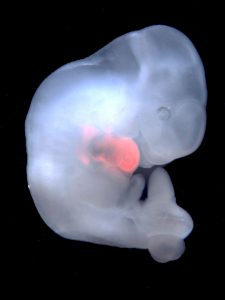No longer just a drawing in old mythology books, chimeras just became real in the research lab. Last week, researchers made the historic announcement they’d successfully grown human cells inside pig embryos. But this wasn’t the only breakthrough in growing chimeras – animals that contain cells from another creature. A second team of scientists also said they’d developed rat-mice hybrids.
Published in the journal Cell, researchers at the Salk Institute in California succeeded in growing pig-human hybrids containing about one human cell to 100,000 pig cells. In all honesty, it’s not a very impressive mix. And the researchers only let the embryos develop for a month for ethical reasons. So we’re not at a point yet where full human organs are growing inside other animals. But it’s a major move because it proved human cells can develop normally in other animals.
The team achieved the hybrid by putting human stem cells into pig embryos and letting them develop in course. They injected pluripotent stem cells (iPSCs), normal adult cells chemically altered to revert back to a stem cell state. The stem cells eventually specialized to become heart cells, skin cells, muscles, and others.
“Nature knows how to educate cells, so in putting the human cells inside the pig embryos, we let nature figure out how to educate them to develop,” Juan Carlos Izpisua Belmonte, senior author on the study told Time Magazine.
A different team led by researchers at Stanford conducted their own research growing rats with mouse pancreas cells. They then transplanted the cells into diabetic mice, allowing the sick mice to restore normal insulin production and reverse symptoms of their diabetes. So they succeeded not just in growing chimeras but also reintroducing the mouse cells back into mice.
The works raise some ethical questions but it’s clear how much value they could have in the future for supplying organs for transplant. Human organs are pretty hard to come by seeing as how they only become available when someone dies. Every ten minutes, someone is added to the national transplant waiting list and 22 people die each day while waiting for a transplant, says the U.S. Department of Health and Human Services.
The U.S. government already has a ban on using federal money to research chimeras. But we may soon need to rethink that ban and along with the implications this work will have on animal rights and our own ethical boundaries. Wherever you might fall on this debate, there’s a lot of research going into using pigs for human organ development. Last April, researchers announced they’d kept a baboon alive on a genetically modified pig heart for over two years. The day may come soon when we no longer have to wait on human donors for human organs.











